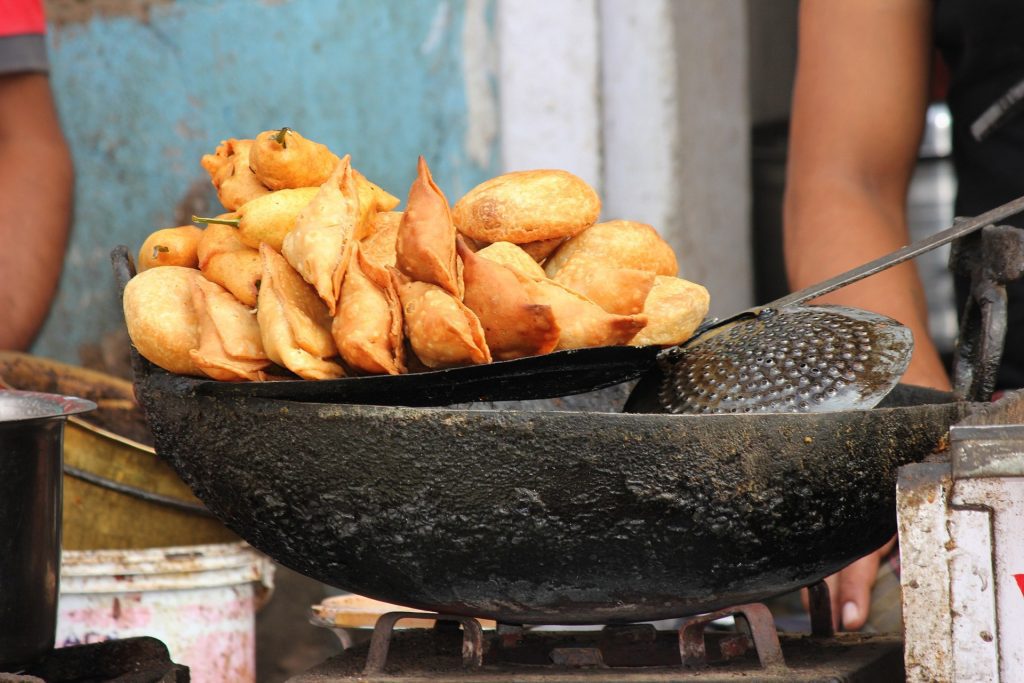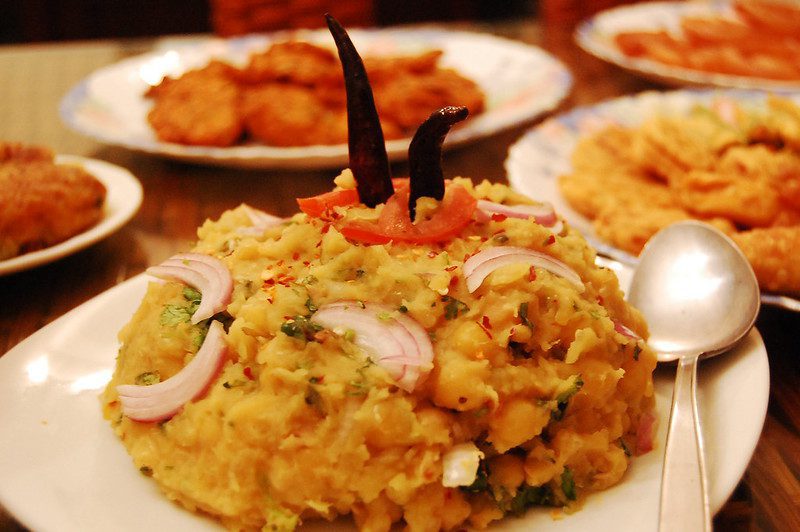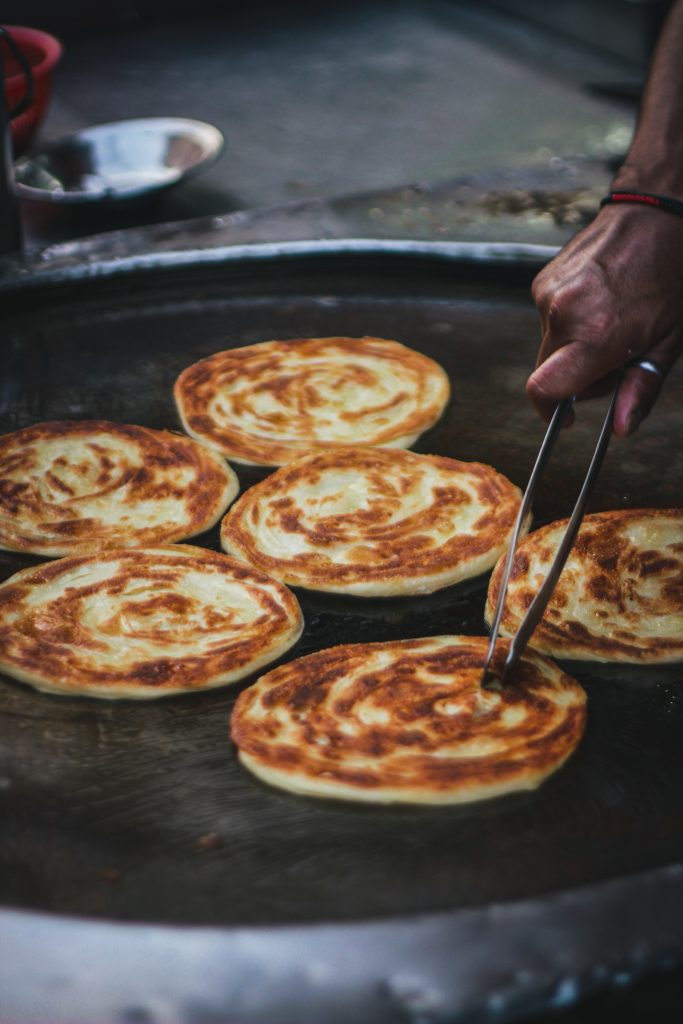Kolkata India is known for its wide variety of high-quality street food, be it the crunchy Chanachur, Nimki, Nizami rolls, or Porottas. I’ve recently covered best sweets to try in Kolkata and here goes a list of the most favorite snacks that you can find on all Kolkata street corners.

Table of Contents
Shingara
Shingara is known as Samosa in other parts of the country, but in Kolkata the taste is authentic, delectable and procures a wide variety of styles. The Shingara is a mound of dough shaped in the style of a three-cornered pizza base. But, lo and behold, it is fattened to the brim with a rich amount of filling, be it potatoes, gram grams, peas, cauliflowers, meat or even chocolate. Yes, you heard that right!

Shingara is served almost twice or thrice every day for office-goers and workers, for it is as filling (or more!) than a breakfast platter. The shops open as early as 6 AM to make the most famous filling, that of whole spices, say cumin, coriander, cardamom, and Garam Masala, to give it a kick as you bite into the beautifully hot, deep-fried goodness. Shingara is eaten in bigger quantities.
As and when the city nears Ramzan (Ramadan), the season of fasts is broken with the ‘Keema Shingara’ (a mutton-chicken filled dough) or ‘Khoya Shingara’ (a sweet option filled with churned milk and dipped in sugar syrup). With the coming of age, you will find a lot more choices – right from Schezwan Shingara to Paneer or Cheese Shingara. Come and try it out!

Phuchka
Phuchka is also called ‘Pani Puri’ or ‘Golgappa’ in India. It is a very thin ball of dough, puffed but vacuum on the inside. It can be easily cracked and filled with a ready-made spiced mixture of potatoes, whole green chilies, and syrups of your choice. It is typically a tradition for us to increase the level of hotness with each bite. It’s also quite common to have many at one go in Phuchka-eating competitions. Typically they are small, kneaded and deep-fried dough, made of either semolina or flour, super-crunchy and crave-able. You can mix and match with sweet tamarind paste or lime-salted water at the end to cleanse your palette and make it even more appetizing. Time to run!

Ghugni
Ghugni is a curry made of dried yellow peas and served with fried shreds of the all-purpose flour dough, typically called Luchi and most beloved as a vegetarian Bengali breakfast option. It is well-cooked only when you make it really creamy. But the key is to maintain the wholeness of the chickpeas so they remain intact. It is never too watery. And it can be served on its own, provided that you have enough chilies, onions, garlic, and an added sweetness of coconut to make it a perfect combo. The dish uses our Bengali-favorite mustard oil, ghee, cinnamon, cloves, and bay leaf, with dried red chilies, tomatoes, and turmeric powder, ginger-garlic paste. ‘Bhaja Moshla’ or roasted spices for flavor. It is a riot in your mouth and oh so worth it!

Mughlai Porotta
The Mughlai Paratha, a must-have dish from Lucknow, takes its place in the Kolkata streets like nothing before. It is a fried Indian bread that is prepared with a stuffing of keema, eggs, pepper and onions and served with a hint of squeezed lemon. The idea revolves around the Turkish Gozleme, introduced in the Bengali Suba (Province) during the reign of the Mughal Empire. Emperor Jahangir’s cook Adil Hafiz Usman is said to have begun the tradition of cooking the same, spreading this around the administrative capitals of Dhaka and Murshidabad too. The variants can be many and the best of the lot can be found in Mitra Cafe, Apanjan, Basanta Cabin, and Sangu Valley.

Aloo Dum
Aloo Dum is a unique dish of Kolkata that has been adopted from Kashmir (northern part of India) and given a twist according to the local styles. The potatoes were domesticated in the area and frequently referred to as the ‘common man’s food’. What makes it different from the Kashmiri Wazwan is the use of distinct spices, onion and garlic, both of which were not used in Vedic cooking. The addition of Yoghurt, aniseed, turmeric and asafoetida successfully poses it on a higher pedestal.
Aloo Dum needs to be cooked really well and snack shops typically keep stir-frying the spices and the potatoes for several hours before the masala is thick and cannot be distinguished from the creamy goodness. Served with ‘Radhaballavi’ or soft Puris filled with dal, it is also a must in the first half of all weddings. Secret: Add cashew paste. Wait and watch. Shhh…

Nimki
Keeping the crunchiest for the end, Nimki, also known as ‘Namkin’ or ‘Namak Para’ does justice to its own name. It means ‘Savory’ personified and it is similar to the Rajasthani Mathri or crunchy strips of pastry, made with refined flour, oil and water, common in Uttar Pradesh and Punjab. Cumin seeds, ajwain, fenugreek leaves, and ghee. That’s all. To hasten the process of cooking it, baking powder is often used, which gives it a zesty end, quite similar to the effect of caraway seeds. Salty snacks are a sign of hospitality for Indians and it is important to serve it no matter what other dish you may have prepared. No evening snack is complete without these crunchy bites but beware of the extra inches in your hips!
If you’ve come to West Bengal in search of an Indian tiger safari, begin in the city with this Kolkata street food.




